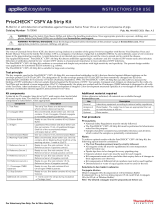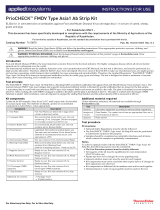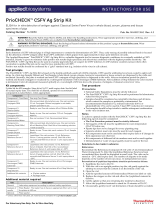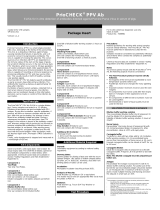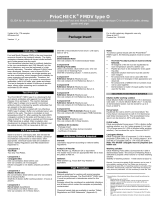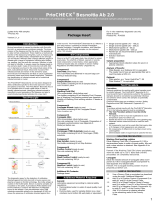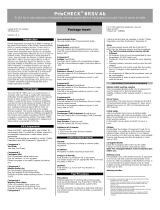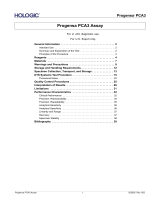Page is loading ...

For Veterinary Use Only. For In Vitro Use Only.
INSTRUCTIONS FOR USE
PrioCHECK™ Bovine BVDV Ab Plate Kit
ELISA for
in vitro
detection of antibodies against Bovine Viral Diarrhea Virus in serum, plasma and (bulk) milk of cattle
Catalog
Number 7588940 Pub. No. MAN0013806 Rev. C
.0
WARNING!
Read the Safety Data Sheets (SDSs) and follow the handling instructions. Wear appropriate protective eyewear, clothing, and
gloves. Safety Data Sheets (SDSs) are available from thermofisher.com/support.
WARNING! POTENTIAL BIOHAZARD.
Read the biological hazard safety information at this product’s page at thermofisher.com. Wear
appropriate protective eyewear, clothing, and gloves.
Introduction
Bovine Viral Diarrhea Virus (BVDV) belongs to the genus Pestivirus of the family Flaviviridae and occurs worldwide. The virus causes abortions in
pregnant cows and an infection leads to major financial damage to milk producers. A BVDV infection during pregnancy may result in infection of the fetus
through transplacental spread of the virus and cause the calf to be persistently infected. Persistent infective animals continuously shed the virus into the
environment resulting in an acute infection in other cattle. Persistently infected animals have no or low levels of specific antibodies.
The Applied Biosystems™ PrioCHECK™ Bovine BVDV Ab Plate Kit detects antibodies against different subtypes of BVDV (Ia, Ib, and II) in serum, plasma
and (bulk) milk samples of cattle. The test can be used to diagnose BVDV infections of individual animals or on a herd level. BVDV infections in individual
animals can be monitored by titration of paired (at least 4-weeks interval) samples. Moreover, the test is a valuable tool in large-scale screening and
eradication programs. In addition, the PrioCHECK™ Bovine BVDV Ab Plate Kit can be used (although not extensively validated) to identify
Pestivirus-specific antibodies in sera from sheep and pigs.
Test principle
The PrioCHECK™ Bovine BVDV Ab Plate Kit employs two monoclonal antibodies (mAb). The two mAb’s recognize different epitopes located on the highly
conserved NS-3 non-structural protein (P80) of BVDV. One mAb is coated to the plate and the second mAb is used as a conjugate. Undiluted test sera,
plasma or undiluted (bulk) milk samples are simultaneously incubated with inactivated BVDV antigen in the wells of the coated plate followed by a
washing step. Subsequently, the working dilution of the conjugate is dispensed and after an incubation period a second washing step follows. In the
subsequent step Chromogen (TMB) Substrate is dispensed to the wells and after incubation the color development is stopped. Color development
measured optically at a wavelength of 450 nm shows the presence of antibodies directed against BVDV.
Kit components
5 plate kit for 440 samples. Store kit at 5±3°C until the expiry date. See kit
label for actual expiry date. The shelf life of diluted, opened, or
reconstituted components is noted below, where appropriate.
Component
Description
1: Test Plate
Five Test Plates.
2: Conjugate (30x)
30x concentrated, dilute before use. One vial
containing 2.5 mL of Conjugate.
3: Dilution Buffer (5x)
5x concentrated, dilute before use. One vial
containing 60 mL of Dilution Buffer. Shelf life of
dilution buffer working solution: 4 hours at 22±3°C.
4: Antigen
Lyophilized. Five vials containing 6.0 mL of
lyophilized Antigen. Shelf life of reconstituted
antigen: until expiry date at −20°C.
5: Horse Serum
Lyophilized. One vial containing 3.5 mL of
lyophilized Horse Serum. Shelf life of reconstituted
horse serum: until expiry date at −20°C.
6: Demineralized Water
One vial containing 10 mL of Demineralized Water.
7: Washing Fluid (200x)
200x concentrate, dilute before use. One vial
containing 60 mL of Washing Fluid. Shelf life of
washing solution: 1 week at 22±3°C.
8: Reference Serum 1
Ready-to-use. One vial containing 1.0 mL of
Reference Serum 1.
9: Reference Serum 2
Ready-to-use. One vial containing 1.0 mL of
Reference Serum 2.
10: Reference Serum 3
Ready-to-use. One vial containing 1.0 mL of
Reference Serum 3.
11: Reference Milk 1
Ready-to-use. One vial containing 1.0 mL of
Reference Milk 1.
12: Reference Milk 2
Ready-to-use. One vial containing 1.0 mL of
Reference Milk 2.
13: Chromogen (TMB)
Substrate
Ready-to-use. One vial containing 60 mL of
Chromogen (TMB) Substrate.
14: Stop Solution
Ready-to-use. One vial containing 60 mL of Stop
Solution.
Additional kit contents
• Package Insert
• 10 plate sealers
Additional material required
Unless otherwise indicated, all materials are available through
thermofisher.com.
Use
Description
General
Laboratory equipment according to national safety regulations.
Analysis of
results
Plate reader e.g. Multiskan EX or equivalent. The reader has to
have an appropriate filter set to read the plates at 450 nm.
Optional
Plate washer.
Test procedure
Precautions
• National Safety Regulations must be strictly followed.
• PrioCHECK™ Bovine BVDV Ab Plate Kit must be performed in
laboratories suited for this purpose.
• Samples should be considered as potentially infectious and all items
which contact the samples as potentially contaminated.
Notes
To achieve optimal results with the PrioCHECK™ Bovine BVDV Ab Plate
Kit, the following aspects must be considered:
• The Test Procedure protocol must be strictly followed.
• All reagents of the kit must be equilibrated to room temperature
(22±3°C) before use.
• Pipette tips have to be changed for every pipetting step.
• Separate solution reservoirs must be used for each reagent.
• Kit components must not be used after their expiry date or if changes in
their appearance are observed.
• Kit components of different kit lot numbers must not be used together.
• Demineralized water or equal must be used for the test.
Solutions to be made in advance
Dilution buffer working solution
The Dilution Buffer (5x) (Component 3) must be diluted 1:5 in demin-
eralized water (1 part Dilution Buffer + 4 parts demineralized water). The
dilution buffer working solution can be stored up to 4 hours at 22±3°C.
Antigen
Equilibrate the vial to 22±3°C and reconstitute the Antigen (Component 4)
with 6.0 mL dilution buffer working solution. Reconstituted antigen can be
stored at −20°C until expiry date.
Horse Serum
Equilibrate the vial to 22±3°C and reconstitute the Horse Serum
(Component 5) with 3.5 mL demineralized water. Reconstituted horse
serum can be stored at −20°C.
Reconstitution of the lyophilized reagents:
1. Equilibrate the vial at room temperature (22±3°C).
2. With the vial in an upright position, tap the vial gently against the table
top to ensure that the content is on the bottom of the vial.
3. Open the vial.
4. Add the specified amount of demineralized water or dilution buffer,
respectively (see label on the vial).
5. Replace the stopper on the vial and allow the lyophilized material to
dissolve.
6. Gently agitate the vial so that any remaining dry material will be dissolved.
7. Allow the solution to stand at least 15 minutes at 22±3°C before use.
8. Mix gently and intermittently (formation of foam should be avoided).

2 PrioCHECK™ Bovine BVDV Ab Plate Kit Instructions for Use
Conjugate buffer
Dilute reconstituted horse serum 1:20 in dilution working buffer solution;
e.g. for one plate prepare 12 mL (add 0.6 mL reconstituted horse serum to
11.4 mL dilution buffer working solution). The conjugate buffer can be
stored up to 4 hours at 22±3°C.
Conjugate dilution
Dilute Conjugate (30x) (Component 2) 1:30 in conjugate buffer; e.g. for one plate
prepare 12 mL (add 400 µL Conjugate (30x) to 11.6 mL conjugate buffer).
Note: The diluted conjugate must be prepared just before use.
Washing solution
Dilute Washing Fluid (200x) (Component 7) 1:200 in demineralized water.
The amount of Washing Fluid is sufficient to prepare a final volume of
12 liters. Stability of washing solution: 1 week stored at 22±3°C.
Note: Commercially available ELISA washers can be used. If not available,
washing of the plate(s) can be done by dispensing at least 200 µL of
washing fluid to all wells of the plate(s). Subsequently, empty the plate(s)
and repeat as many times as prescribed. It is not necessary to soak the
plate(s) between washings. Tap the plate(s) firmly after the last washing.
Note: See Appendix B for sample preparation procedure and storage.
Incubation of test samples, antigen and conjugate
1. Dispense 100 µL of dilution buffer working solution to the wells
A1 and B1 (= OD450 blank).
2. Dispense 50 µL of the appropriate reference sample to the wells that are
specified in the following table.
Reagent
Wells
Sample type: serum or plasma
Reference Serum 1 (Component 8)
C1 and D1 (=OD
450
max)
Reference Serum 2 (Component 9)
E1 and F1
Reference Serum 3 (Component 10)
G1 and H1
Sample type: milk (individual or tank)
Reference Milk 1 (Component 11)
C1 and D1 (=OD
450
max)
Reference Milk 2 (Component 12)
E1 and F1
3. Dispense 50 µL of the test samples to the remaining wells.
4. Dispense 50 µL of the reconstituted BVDV antigen to all wells except
wells A1 and B1.
5. Cover and shake the Test Plate (Component 1) gently.
6. Incubate the Test Plate for 60±5 minutes at 22±3°C.
7. Empty the Test Plate and wash 6 times with diluted washing fluid. Tap
the plates firmly after the last wash cycle.
8. Dispense 100 µL of the diluted conjugate to all wells.
9. Cover the Test Plate and incubate for 60±5 minutes at 22±3°C.
Incubation with Chromogen (TMB) Substrate
1. Empty the Test Plate and wash 6 times with diluted washing fluid. Tap
the plate firmly after the last wash cycle.
2. Dispense 100 µL of the Chromogen (TMB) Substrate (Component 13) to
all wells.
3. Incubate the Test Plate for 15 minutes at 22±3 °C.
4. Add 100 µL of Stop Solution (Component 14) to all wells.
5. Mix the contents of the wells of the Test Plate.
Note: Start the addition of Stop Solution 15 minutes after the first well was filled
with Chromogen (TMB) Substrate. Add the Stop Solution in the same order and
at the same pace as the Chromogen (TMB) Substrate was dispensed.
Reading of the test and calculating the results
1. Measure the optical density (OD) of the wells at 450 nm within
15 minutes after color development has been stopped.
2. Calculate the mean OD450 of wells A1 and B1 (= OD450 blank).
3. Calculate the corrected OD450 of all samples by subtracting the
mean OD450 blank.
4. Calculate the mean of the corrected OD450 of wells C1 and D1
(= OD450 max).
5. Calculate the percent inhibition (PI) of the reference and test samples
in wells E1 to H12 using the following formula.
The corrected OD450 of all samples is expressed as percent inhibition (PI)
relative to the corrected OD450 max:
PI = 100 − (corrected OD450 test sample / corrected OD450 max) × 100
Result interpretation
Validation criteria
1. The mean OD450 blank (A1 and B1) must be <0.150.
2. The corrected mean OD450 max (wells C1 and D1) must be ≥1.000 for
Reference Serum 1, or ≥0.800 for Reference Milk 1.
3. The percent inhibition of Reference Serum 2 must be >50.
4. The percent inhibition of Reference Serum 3 must be <50.
5. The percent inhibition of Reference Milk 2 must be >30.
Not meeting these criteria is reason to discard the results of that specific test
plate.
Note: If the corrected mean OD450 is below 1.000 possibly the Chromogen
(TMB) Substrate is too cold. In that case pre-warm the solution to 22±3°C or
incubate up to 30 minutes.
Interpretation of the percent inhibition
Serum and plasma samples
PI = <50% Negative
BVDV-specific antibodies are absent in the
test sample.
PI = ≥50% Positive
BVDV-specific antibodies are present in the
test sample.
In case serum or plasma test samples have been titrated, the antibody titre
of a sample is defined as the reciprocal of the highest dilution which gives
PI ≥50%.
A transient BVDV infection is diagnosed when in paired test samples,
collected during the acute phase and more than four weeks later, the
antibody titre changes from undetectable levels to detectable levels or
shows a fourfold rise in antibody titre.
Milk samples
PI = <30% Negative
BVDV-specific antibodies are absent in
the test sample.
PI = ≥30% Positive
BVDV-specific antibodies are present in
the test sample.
Recommended plate layouts
The following plate layouts allow for efficient transfer of pre-diluted samples
and controls to the Test Plate (B — dilution buffer working solution; R1 —
Reference 1; R2 — Reference 2; R3 — Reference 3 (optional); S — Sample).
Table 1 Plate layouts: Test Plate
1
2
3
4
5
6
7
8
9
10
11
12
A
B
S
S
S
S
S
S
S
S
S
S
S
B
B
S
S
S
S
S
S
S
S
S
S
S
C
R1
S
S
S
S
S
S
S
S
S
S
S
D
R1
S
S
S
S
S
S
S
S
S
S
S
E
R2
S
S
S
S
S
S
S
S
S
S
S
F
R2
S
S
S
S
S
S
S
S
S
S
S
G
R3 or S
S
S
S
S
S
S
S
S
S
S
S
H
R3 or S
S
S
S
S
S
S
S
S
S
S
S
Appendix A – References
1. Deregt D and Loewen KG (1995). Can Vet J 36:371−378.
2. Kramps JA, Van Maanen C, Van de Wetering G, Stienstra G, Quak S,
Brinkhof J, Ronsholt L, Nylin B (1999). Vet Microbiol Jan. 64(2-3):135−144.
3. Paton DJ, Ibata G, Edwards S, Wensvoort G (1991). J Vir Meth
31:315−324.
Appendix B – Sample preparation procedure and storage
Milk
Serum and plasma
• Prior to testing, milk
samples should be defatted
by centrifugation for 15 min.
at 1000 × g. Use a pipette to
collect a test sample from
underneath the creamy
layer. As an alternative to
centrifuging the samples
may be kept refrigerated for
at least 16 hours.
• Defatted milk samples can
be stored at −20°C before
testing.
• Serum and plasma samples can be
stored at −20°C before testing.
• Serum or plasma samples can be
titrated in the PrioCHECK™ Bovine
BVDV Ab Plate Kit. For this purpose
prepare two-fold serial dilutions (1:10
to 1:1280) in dilution buffer.
• Occasionally, freshly collected serum
and plasma samples may give a weak
false-positive test result. Freezing and
thawing the samples once or by
inactivation at 56°C for 30 minutes
avoids this phenomenon.

thermofisher.com/support | thermofisher.com/askaquestion
thermofisher.com
01 November 2022
Customer and technical support
Technical support: visit thermofisher.com/askaquestion
Visit thermofisher.com/support for the latest in services and support,
including:
• Worldwide contact telephone numbers
• Order and web support
• User guides, manuals, and protocols
• Certificates of Analysis
• Safety Data Sheets (SDSs; also known as MSDSs)
NOTE: For SDSs for reagents and chemicals from other manufacturers,
contact the manufacturer.
Limited product warranty
Life Technologies Corporation and/or its affiliate(s) warrant their products as
set forth in the Life Technologies' General Terms and Conditions of Sale found
on Life Technologies' website at www.thermofisher.com/us/en/home/global/
terms-and-conditions.html. If you have any questions, please contact Life
Technologies at thermofisher.com/support.
Prionics Lelystad B.V. | Platinastraat 33 | 8211 AR Lelystad | The Netherlands
The information in this guide is subject to change without notice.
DISCLAIMER: TO THE EXTENT ALLOWED BY LAW, LIFE TECHNOLOGIES AND/OR ITS AFFILIATE(S) WILL
NOT BE LIABLE FOR SPECIAL, INCIDENTAL, INDIRECT, PUNITIVE, MULTIPLE, OR CONSEQUENTIAL
DAMAGES IN CONNECTION WITH OR ARISING FROM THIS DOCUMENT, INCLUDING YOUR USE OF IT.
Revision history of Pub. No. MAN0013806 (English)
Rev.
Date
Description
C.0 01 November 2022
The Validation criteria for Reference Serum 1 and Reference Milk 1
were updated.
B.0 11 March 2022
• The Reference Milk 1 and Reference Milk 2 were added to the
document (see Kit components, Test procedure, and Result
interpretation).
• The Recommended plate layouts were added to the document.
A.0 24 July 2019
• New document. Converted the legacy document (PrioCHECK BVDV
Ab 7588940 v1.0_e) to the current document template, with
associated updates to the publication number, limited license
information, warranty, trademarks, and logos.
• The product name was changed from PrioCHECK® BVDV Ab to
PrioCHECK
™
Bovine BVDV Ab Plate Kit
Important Licensing Information: These products may be covered by one or more Limited Use Label
Licenses. By use of these products, you accept the terms and conditions of all applicable Limited Use
Label Licenses.
©2022 Thermo Fisher Scientific Inc. All rights reserved. All trademarks are the property of Thermo
Fisher Scientific and its subsidiaries unless otherwise specified.
/
